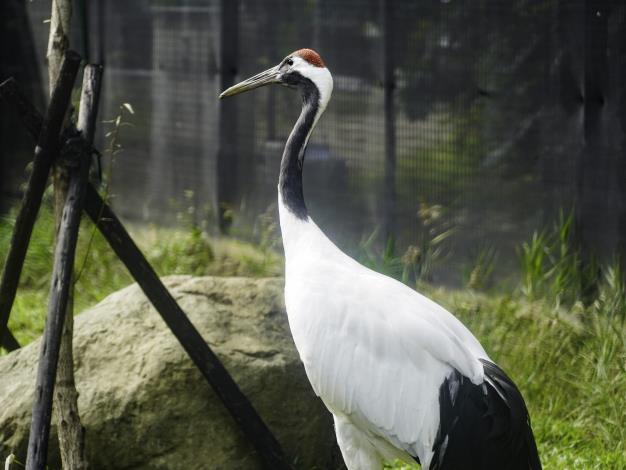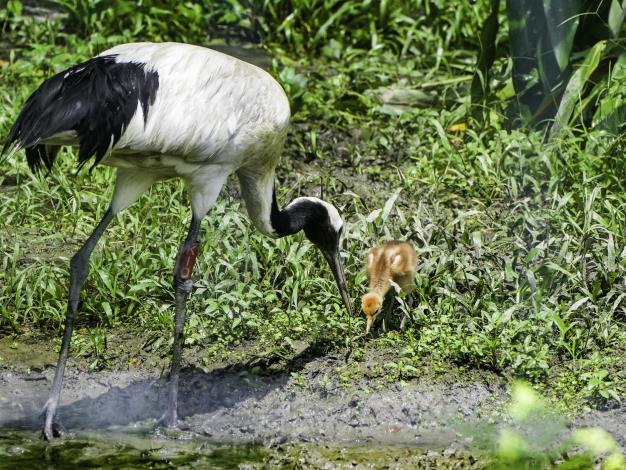BIG is Not Soft Anymore! He Finally Has a Kid!
On the afternoon of Summer Solstice (June 21st), the zookeeper of red-crowned cranes finally brought us some good news, the red-crowned crane “KIKA” was wandering around bushes with a newborn. It’s been 11 years since the red-crowned cranes “KIKA” and “BIG” first moved to Taiwan from Japan, and they finally succeed to reproduce naturally under the high expectation and cooperation between zoos in Taiwan and Japan. KIKA and BIG came to Taiwan from Kushiro Zoo in Hokkaido, Japan by chartered plane on September 14th, 2011. Polyculture pairing has started progressively since 2014 and succeeded to give birth to their first clutch of eggs in 2015. Every year during the breeding season, KIKA likes to dance its courtship dance for BIG, and BIG does respond sometimes so staff at Taipei Zoo have always expected a newborn. Zookeepers have adjusted the recipes for breeding reasons, expanded the living area to be more natural, improved stimulators, added micronutrients, and even tried the artificial incubation method, all just to increase the production of the eggs and the hatchability. However, many years have gone by, and eggs either failed to get pregnant or failed to grow after using the artificial incubation method. Surprisingly, the fact that KIKA and BIG gave birth to three clutches of eggs all by themselves shocked everyone in Taipei Zoo. Red-crowned cranes are precocial species so they can walk and eat around once they’re born. KIKA is mostly in charge of raising their kids and BIG spends most of its time on protection. Taipei Zoo wants everyone to keep quiet and not to slam the protection bars to draw attention because KIKA will hide their kids and BIG will attack “invaders” if they feel threatened. Taipei Zoo recommended watching from the Amphibian & Reptile House with a telescope since the newborn is still very fragile and the view is actually better from there. Taipei Zoo and Kushiro Zoo in Japan concluded a friendship treaty to protect the endangered red-crowned cranes in 2012, and it was the first time Japan gave a foreign country such a “Special Natural Souvenir”, the red-crowned cranes. The current director of the Kushiro Zoo, Takahiro Suzuki, heard about the news, he not only sent the newborn his best wishes but also gave Taipei Zoo many suggestions about the newbie’s foods, natural enemies, nutrition, and living areas. Caretakers in Taipei Zoo are also trying their best to make the most suitable foods for the baby red-crowned crane. This is the first time in both 17-year-old KIKA and 20-year-old BIG’s lives they’re going to take care of a baby, and from observation, they’re apparently quite responsible. Red-crowned cranes’ beaks are sharp and keen, and BIG likes to use his beak to keep enemies away, even when caretakers came to feed them or work, he likes to use it to keep them away. Although it’s quite troublesome to go to Japan for red-crowned cranes during the pandemic, you can come to Taipei Zoo and check it out, fledgling grows really fast, and we’ll see our newbie around in no time for sure. This is actually not the first time Taiwan has bred red-crowned cranes. The earliest record of breeding red-crowned cranes in Taiwan was at the residence of the Taiwan Governor-General when Taiwan was ruled by Japan. After the Taipei Zoo was established in 1913, the red-crowned cranes were moved from the residence to the zoo. There were records of the birth of two red-crowned cranes in 1918 but there’s no other successful breeding record of red-crowned cranes until now.


![Taiwan.gov.tw [ open a new window]](/images/egov.png)
